#this was the only kind of full view I had of Swiss all ritual :')
Photo


If you watch for long enough the stomps sync up [X]
#the band ghost#swiss ghoul#nameless ghoul Swiss#Trenton ritual#this was the only kind of full view I had of Swiss all ritual :')
415 notes
·
View notes
Text
Headcanon Masterlist
|| Yeah, I needed an entirely separate post for just my headcanons! Haha
note: outdated = I no longer believe this or like the headcanon, semi-outdated = I kind of like the headcanon, but there are facets of it I no longer enjoy or believe.
Multiple Papa’s / General Papal Lore
Papa Nihil, I, II and III Teeth Headcanons + pictures (semi-outdated)
Differences between resurrected ghouls through the Eras (Papa I, II & III) (OUTDATED)
Comprehensive Papa Supernatural Power + Ability masterlist
The Clergy once attempted to house all Papas together... once
All the Papa + Cardinal Copia’s associated weapons (crack)
Papa pupil Headcanon + infographic (semi-outdated)
Both Papa’s and Ghouls have specific periods of heat/rut during the year
Papa finger-nail/talon headcanon
Papa fertile period headcanons
Papa Speaking Pattern headcanons
Era building scheme headcanon
Papa Papacy symbolism + Cardinal Copia (this aged really well ngl)
Papal makeup is supernatural and the Papa’s are cryptids; and more at 11
When forced to run, Papa’s have to pull a Disney princess and lift up their chasuble ( more on this here )
Papa true age/human age headcanon (semi-outdated)
The Papa’s have their own ‘true tongue’ similar to Ghoulish
Dark emeritus brother headcanons (this headcanon isn’t outdated, more a dark interpretation shitpost)
Papal skeletal face paint headcanon (semi-outdated, canon kinda went against this, but that’s questionable itself, given former sisters of sin never had facepaint, thereby bringing into question whether they’re mere sisters or a higher rank that shares habits)
How Primemovers work/get assigned
Papa dicks headcanon + Copia
Papa I, II and III birth name headcanons
Ghost Project/The Church’s ultimate goal
The four original Papa’s regarding children
Papa I, II, III and Popia’s MBTI
Papa I, II and III favourite foods and drinks
The Papa’s naturally grow horns
How to make a Papa purr without fail
Papa Anatomy Headcanon (semi-outdated)
Papa I, II and III dealing with a sibling (not assigned to them) being friendly and happy with them
Papa’s and the occult
Where is the ministry located and how did they get there?
Papa Nihil
Papa Nihil being first introduced to a baby Papa II and Papa III (semi-outdated)
Nihil always wanted a daughter (sexism tw)
Papa I
Papa I doesn’t really enjoy one night stands
Papa I & II fashion headcanon
Papa I isn’t fully white
Papa I will not allow the young or vulnerable to have hearing protection at his show + his partial deafness
Papa I enjoys gifting small jewellery to his s/o
Papa I headcanons (OUTDATED)
Papa I & III reactions to finding an anonymous bouquet of roses for them (+character study)
Papa II
What I believe the best time for Papa II is (semi-outdated)
How Papa II says ‘I love you,’ his stance on PDA and when he lost his virginity (semi-outdated)
Sister Imperator being Papa II’s mom
Cardi C being Papa II’s son (OUTDATED)
Papa II natal chart
How is Papa II for eye contact during sex
Papa II’s signature sunglasses are custom
Papa II has had two prime-movers (semi-outdated)
Having Papa II fall in love with you would include (semi-outdated)
Papa II’s greatest regret
Papa II’s opinion on thiccness (semi-outdated)
Papa II doesn’t like colourful/patterned socks
Papa II’s Papal Ferula isn’t just for show (semi-outdated)
Papa II misses how close he used to be with Papa III
Papa II instinct is always to protect those around him
Papa II’s favourite Ghoul
Papa II pals around with Omega
Despite his hatred for Papa II still secretly desires his approval
Papa II only sits like a substitute gym teacher
Papa II is always ready to square-up
How would Papa II react to someone trying to help him overcome his trauma
Would Papa II be protective over his kin/children?
Papa II dossier
The storyline of Circe takes place with Papa II, not Papa III
Papa II nearly put Bon Jovi on Infestissumam for his cover
Papa II doesn’t despise children and does, in fact, have the dad instinct
Papa II doesn’t give a fuck but this doesn’t mean he doesn’t care
Papa I & II fashion headcanon
Papa II gentle lovemaking hc (this is more an imagine though??? idk)
Papa II & III + primal play
Papa II on the first date (OUTDATED)
Papa II is selfish
Papa II & III’s relationship (THEY’RE SUPER CLOSE AND THEY LOVE EACH OTHER YOU EDGELORDS)
Papa II doesn’t go out of his way to glamour himself
Papa II can play the organ
Papa II often tried to seek out his father as a boy
Papa II’s titles, because he’s an extra bastard
Papa II has a gold tooth
Papa II picks at his talon when bored or impatient
Papa II is a secret romantic
Papa II’s hair type
Papa II with an insecure partner
Papa III
Papa III regarding ghouls with missing limbs/digits, etc.
Papa III’s reaction to getting someone pregnant
Papa III didn’t have a nice childhood, or so to speak (semi-outdated)
Papa III refuses to have sex with a conversation first
Papa III can be the living embodiment of a spoiled brat (semi-outdated)
Papa III is an AFAB trans-man (not outdated! I still love this headcanon, I just don’t write it as often anymore)
Papa III, regardless of verse, is always the last to die
Papa III is scared of violent storms
Papa III is the only Papa to let his ghouls call him Papa
Papa III + applicable life skills (spoiler: he doesn’t have many)
Papa III unapologetically tears up during sex
Papa III has ADHD
Papa II & III + primal play
Papa III favourite kinks
Papa III needs therapy: a masterpost
Papa III’s only photo of his mother
Papa II & III’s relationship (THEY LOVE EACH OTHER)
Papa III tries to befriend his ghouls and views them more like pals than meaningless servants (semi-outdated)
Papa III talking in his sleep and mumbling
Papa I & III reactions to finding an anonymous bouquet of roses for them (+character study)
Cardinal Copia / Popia
Copia is the type of guy to get his s/o flowers
Copia will do a little happy dance when excited
Copia is autistic
Copia + having a mommy kink (y’all are heathens istg)
Sub Copia headcanons
Popia jealousy headcanon
Copia with an S/O that plays full contact sports
Copia signs off business emails with an emoji
General Ghoul Headcanons
The Ghoul’s have a far more refined sense of smell
The Ghouls, like rabbits, will headbutt for attention and affection
The Ghoul’s regarding human periods
Ghoul death/veneration headcanon
Ghoul Temperature headcanons
Ghoul anatomy headcanon
Ghoul body mod culture headcanons + piercings
You can trance Ghouls
Ghoul sounds headcanon (not nsfw surprisingly!)
Can Ghouls and Humans procreate with each other?
Ghouls + bodily insecurity
The Ghouls are trained like bridesmaids to help their Papa in fashion disasters
Ghoul Mating Rituals
Ghoul Strength headcanons
Church Reaction to Ghoul’s dating
Ghoul’s can impact the dreams of the sleeping headcanon
Friends to Lovers series
Friends to lovers: Cumulus
Friends to lovers: Cirrus
Friends to lovers: Dewdrop
Era 4 Ghouls
Ghoul dicks headcanon (Era 4 only)
Era 4 Ghoul Guilty Pleasure headcanon
How the Ghouls would handle their chubby S/O being taunted or treated poorly because of their weight
Aether, Dew and Mountain with a seriously sick S/O
Dew refuses to wear clothes + why
Rambling about Dewdrop
Dew can and will steal your stuff
Fluffy Dewdrop headcanons
How to really piss off Dewdrop
Rain + the sub or dom debate
Cumulus & Mountain NSFW headcanons
Mountain + a smaller lover headcanons
Mountain refuses to be ‘that huge ghoul’
General Swiss headcanons
Swiss loves making nicknames for people
Other Ghoul Headcanons
Era 2-3.3 Ghoul Zodiac Signs
Special Ghoul headcanons
#ghost bc#ghost band#Papa Emeritus#cardinal copia#nameless ghoul#THIS TOOK FOREVER AND I DON'T THINK I GOT EVERYTHING#END ME
218 notes
·
View notes
Text
Gender roles, witches, demons and Hereditary. A film essay and review.
An opinionated and biased essay ahead, perfectly imperfect. This writer is aware of said bias's and welcomes your ideas respectuflly. Proceed.
Halfway through his movie, I turned to my husband and said, “I think we might need therapy when this is all over.” I’d like to start with a caveat that we are a household that loves horror movies. In my opinion, horror is an under-appreciated genre. I'm not talking about franchise horror films, of which we are not a fan, with the exception of Insidious. I'm talking, The Shining, Blair Witch Project, Suspiria, Mommy, Let The Right One In, Babbadook. Classic horror tales and the like. Greek tragedies, even Shakespear. I have a lot to say about this one. So fair warning, this essay is long.
A QUICK BACKGROUND
I grew up reading Steven King, Bram Stoker, Mary Shelly, Edgar Allen Poe, Anne Rice and Mark Danielewski. I would argue that even my favorite fantasy and science fiction writers like Tolkien and George R.R. Martin borrow from the horror genre.
What solidified my interest in horror was actually a class in Chinese and Japanese cinema and art history. I enjoyed studying the nuances of the culture through the stories they told. Most of which were ghost stories. Ancestral worship is part of their culture. When visiting someones home, you might find a shrine to their passed loved ones. Ghosts are a normal, everyday part of their spiritual life. So too are their ghost stories.
This connection to the dead is apparent in many cultures. The Celtic festival of Samhain, The Buddhist Obon, Dia De Los Muertos, Chuseok in Korea and Gai Jatra in Nepal. All have ceremonies and celebrations that honor ancestral spirits. Essentially, the ghosts of your family. I joke that even the Bible is one long ghost story. Full of death, rebirth, angels, demons, spirits, voices and apocalyptic visions. But where eastern religions and ancient cultures differ is around the premise of fear. Specifically spirits.
Take, for instance, the Buddhist Obon and Del Dia De Los Muertos. Celebrations designed to honor the people who came before you. Essentially, one envokes the spirits of your ancestors come back to visit the living. One would light lanterns or lay a path of flowers to guide those spirits back to earth for the celebration. You are literally inviting ghosts to come and have dinner with you. These rituals are not fear based spiritual practices. You will find no children running away in horror from the ghosts of great granddad. They are beautiful rituals full of dancing, prayer, and community.
I grew up going to Church for a large part of my life, so my religious experiences of adolescence are based on my experiences with the Chrisitan church. Here notes my personal bias. I have no such memories of honoring my ancestors in a such a way from the Church. In fact, anything involving something seance-like would have been viewed as the devil. The dead are mourned in quiet reverence but one must be careful in creating any false idols. The only ghost that is ok to envoke, is the holy ghost. It's still very old testement thinking when it comes to this one.
I have a vivid memory of sitting on a picnic bench at Jesus camp, 13 years old, sobbing uncontrollably. I just listened to a fiery sermon about hell and I was truly conflicted. I was already "saved," having said the prayer and done the ritual at 8 years old. But my father was not. He was an atheist. I didn't want him to go to hell. I was terrified and felt guilty. My counselor at the time kept pressing me to call him. She wanted me to "get him saved," right now.
As an adult, I see how flawed that moment was. I did not call my father that night. I couldn't understand how my Christian peers thought less of me for doing so. I thought for sure that God would understand my compassion. My father and I had already discussed his feelings. He always respected my right to choose a religion, and I liked that, so I respected his. But that is not how I was treated by members of the Church. Needless to say, my relationship with the Church ended shortly thereafter and became an agnostic in my adult life.
I could give many instances of examples of why I feel that Christianity is a fear based religion, but I am not defending that point for this essay. Let's assume that it is.
I think it's interesting that our writer for Hereditary uses Goetia as it's religious influence. Goetia, an ancient Greek word that literally means sorcerer, get's its roots from the 16th century. Later, during the Renaissance, it became dubbed "black magic." The backdrop for the ending of the film and it's 17th-century Greek influence, we will explore later. But culturally, I think it's worth looking at this film through an American lens, of which, most of the population is Christian, making the comparisons I make relevant. Hereditary is an American film, written by an American writer. So I don't think he is trying to say anything specific about religion, other than to use it as a horror construct. This writer is obviously aware of his audience and is using that within his film.
We like horror films about evil, possession and ghosts almost as much as we like superhero movies. That classic good versus evil fight. We love it when the lines are drawn in the sand and the tension is clear. We don't get that kind of clarity in life. In fact, life is made up of many unknowns and gray areas. Those two, a cause of our fear and anxiety.
Hereditary doesn't put this idea front and center. Which is why I love it. The supernatural takes a back seat up until the second act. It dives headfirst into the gray areas to establish our characters and keeps us in the deepend with our worst fears.
ABOUT HEREDITARY - NON-SPOILER REVIEW
Hereditary is brilliantly written and performed. If I were awarding Oscars, I would give one to the writer and one to the lead actress. The writing and specifically her performance is award worthy. It is visually stunning and draws from some of the best ancient storytelling techniques of the ages. Its greek tragedy influence is what makes the whole story so strong. The best moments are the long takes, the timing of the edit, the absence of music and truly breathless performances.
But I would argue that the best thing about Hereditary is what it doesn’t explicitly say. Like a Greek Tragedy, it’s about the things that take place in-between the lines that make it so terrifying. It’s a spiritual horror film that speaks to our fears of inheriting the tragedies and traits of our ancestors. It’s about secrets between parents and children. Grief and it’s emotional manifestations. How tragedy can transform a person. It’s about the unspeakable terror that leads to more questions than answers. If you are looking for a nice bow-tie ending, you won’t get it. You are more likely to walk away going, “huh?” I loved the ending, but I think it will turn a lot of people off. It’s not what you are used to these days.
The best thing about the movie, in my opinion, is about women, spirituality, possession, and emotion. Which leads us to the essay below. I won’t be diving into Greek Tragedy or deconstruction of its uses in horror films. That’s for another day. I think it’s been widely documented in reviews thus far. I’d like to take a look at Gender, Christianity, Religion and how this film plays with those larger social constructs.
GENDER ROLES IN HORROR FILMS
Gender roles in horror films are one of my favorite things to pick apart culturally. If you want to dive in more, this is an excellent place to start. Women in horror films have a long history of being gas-lighted by the male characters they interact within the plot. They are scorned with male “logic,” that the things they are experiencing aren’t real. Usually, they are tortured, shallow characters that look pretty and scream on cue. Often viewed as “crazy,” and spend most of the plot running from danger. This isn't always the case, there are a few standouts. But for the most part, I think the above is true. Women are either victims or "witches," in the majority of horror films. I also think it's interesting how we treat women who are having spiritual experiences. In our stories, we are uncomfortable with female emotion. Therefore, if someone is having an extremely emotional experience, we are likely to view them as scary.
We are at our roots a Puritan nation. One whose fear of “the devil,” allowed us to pillage “savage Indians,” in the name of that fear. Europe during the sixteenth and seventeenth centuries persecuted thousands of witches. Whole villages of Swiss women were wiped out in the hysteria.
In America, we have the Salem witch trials.
I recently got to visit Salem Massachusetts. I read this fantastic book before I went called, “A Delusion Of Satan, The full story of the Salem witch trials.” Which outlines in more context the conditions and beliefs that lead to the "witch hysteria.” Today, those Puritans have received their Karma. Salem is a joke. It’s become a tourist Halloween town. Complete with haunted houses, tarot readers, and hippie spiritualists. The “devil,” they so fought to destroy has won. I laughed thinking about the righteous judges jumping through time to see children running around in witch costumes pretending to put spells on each other in their beloved village.
The story of Salem became a cautionary tale of the dangers of religious belief. But the book attempts to take it one step further in outlining the gender roles of women, power dynamics between men and women and femininity, creativity and inspiration. Unlike the modern telling of the story like “The Crucible,” the book deliciously researches connections from historical records. The trials were meticulously documented. Which may be why the story has been passed down to new generations and became taught in schools. But the book makes some connections for me that my 5th-grade classroom reading of The Crucible didn’t.
Life was hard as a puritan and men made all the rules. Imagination was stifled among children. Art was functional. Creativity was not encouraged, survival was. Sexuality was almost exclusively prohibited as a sin of the flesh with the exception of procreation. Pleasure was not allowed. Expression among women was silenced. These are all feminine values. Women who express extreme emotion are “crazy,” while men who express themselves in extreme ways are “passionate.” Soon “crazy,” became “a witch.” Any outburst of extreme emotion and a woman could be accused of being possessed by the devil. Witch hunting thus became inherently female and while anyone a could be accused of being a witch, most of the persecution was of women.
As a little girl, I played a lot in an imaginative space. I experimented with all kinds of storytelling and play acting. As a teenager, I was emotional and dramatic. I guarantee if I had been observed by a Puritan priest, they would have convinced the town that I was possessed. I think most artists would have been accused of witchcraft in that era.
These tropes still exist today. We still silence women. We write stories where they are silenced by others. In a large majority of our horror films, women are either the victims or for lack of a better term, "witches." As time moved on, we stopped persecuting witches and started locking women up in asylums for misbehaving. Thus replacing "witch," with "crazy."
I’m sure at some point, we have all thought our mothers to be “crazy,” through this lens too. Extreme imaginative outbursts or expressions of emotion are squashed in our society. We can barely handle a crying baby on an airplane let alone a woman who cries in public.
And here marks the line of spoilers people. If you wish to continue, do so at your own risk. I am about to talk about the details of the story.
GENDER, DEMONS AND WITCHES IN HEREDITARY
Hereditary begins with our main character, Annie, in the midst of working on her art. She creates model dioramas. It is implied as the story chugs along that these dioramas are her emotional outlet. This is how she processes grief, anger, and fear. The tension between imagination, memory, and reality play nicely here. Why in the world would someone make a miniaturized model of the death of her mother?
I enjoyed the duality of the models with life. The idea that I could take memories and tragedies out of my head and examine them as real-life objects. To see if I could make sense of them, process them differently. This process apears painstaking in the film. The details are fussed over, out main character possessed with the idea of recreation. A rebirth of her pain. Nicely done.
Next, we meet Charlie. Charlie is different. She makes you uncomfortable but we trust her slightly more because we assume it’s a mental disorder. The play on gender here is masterfully done. Our young actress is phenomenal but I question the casting choice. We love to put our humanly different in horror films and this borders exploitation for me. It's akin to pointing at her and calling her "freak." I get that we are establishing a long line of mental health issues for our characters, so I'll leave this one be. But do better next time.
Next, the shocking tragedy that propels our characters into some of the best moments of the film. Personally, I did not see that one coming. The car accident begins our true emotional terror.
Annie experiences real grief for the first time in the loss of her daughter. She was relieved when her own mother died, having been released from the burden of that relationship only to be thrust forward into the guilt of playing a part in her own daughter's death. Grief is not handled lightly here. Our main character moves through hysteric fits. She retreats. She creates twisted dioramas of the accident. All the while her husband grows more and more suspicious of her behavior. Her husband literally acts as men have throughout history. Questioning the intensity of her emotions and wondering if he should send her away. If we are sticking with our horror metaphors, Annie is possessed by grief.
My favorite scene to illustrate this concept is at the dinner table. Tensions mount in the household to an emotional breaking point. Our male characters confront our female lead and claim that she isn’t being truthful about her feelings. They invite her to express herself.
She does. This eruption is the best scene in the film. Rarely do we get to experience female emotional flow on the screen. The sight of a woman in full emotional and visual expression makes our male characters physically retreat from the scene. The very thing they invited her to express is the very thing they can not handle and rather than applaud her completion of this expression, they squash it. The men refuse to join her and instead they persecute her almost as if saying, "burn the witch.’ The refreshing length of the shot and the stellar performance by the actress is noteworthy. They do not shy away from the complexities of extreme emotions.
I think all of us are afraid that if we let go on some level, what comes forth would be bad. Tapping into our emotional flow is scary. So scary that as a society we can’t handle people doing it in front of us. We tell each other, “don’t cry,” when comforting one another. We tell our men, “crying isn’t manly.” And when we see our lead actress express herself on screen, we too as an audience are scared. We question her sanity, if only for a moment. Can we pause for a moment to admire the cinematography choice here? It's like an 18th century painting.
I mean, look at that still shot above. Gorgeous terrifying women in full power feeling herself fully. Just hand Tonni Collect the Oscar, please. This scene is fucking amazing. I applauded Annie's capacity to let go and laughed when the men wouldn't join her. Granted, it has taken me a long time to be ok with my own extremities of emotions but now that I am, I was praising this goddess on screen. I honestly can't think of another on screen performance that accomplishes this as well as Hereditary does.
Emotoins escalate as the film begins introducing the supernatural to the plot. Annie, meets with a new friend in her grief group, this friend conducts a saence to bring back the spirit of her grandchild. It seems to work and despite her reservations, she tries it. This triggers the climax of our film and leads to its ultimate resolution after discovering that her mother had a secret spiritual life. Spirituality “literally," kept in a box and hidden away until the very end of the film. I think spirituality is what our writer wants you to infer as the "hereditary trait." It’s the thing that our lead character doesn’t want to inherit from her mother. Her secret life. Her mental illness. Her spirituality. One might even say, she demonizes her mother. 😉
CHARLIE
The gender play with Charlie is also worth noting. At the conclusion of the film, we learn that Charlie is a male demon reincarnated into a female body. His name is Paimon. His rencarnation into Charlie was a mistake, as we learn at the conclusion of the film. The whole film is a plot to correct this mistake. Charlie referenced as she presents more like a tomboy with an androgynous name. While women are often “Witches,” in our scary stories so to men are painted as “Demons.”
I always wondered why this trope existed in our storytelling. Sometimes I think it's about dominance and submission, Witches serve Demons. Men subservient to women. Demons are usually powerful creatures in our stories. Females are usually the victims of demon possession, either used for literal possession or for impregnation. But it wasn’t always that way.
In the pre-Christian era, demons were both male and female. Much like the ancient polytheistic religions that had many gods and goddesses, so too was the gender spectrum of demons. It’s Christianity that spun the gender roles and made them sexless. Technically, Christian demons are fallen angels, as referenced in the Bible. They are sexless beings whose purpose is to test human beings on their faith in God and lead them to sin.
"For such men are false apostles, deceitful workmen, masquerading as apostles of Christ. 14. And no wonder, for Satan himself masquerades as an angel of light. 15. It is not surprising, then, if his servants masquerade as servants of righteousness. Their end will be what their actions deserve.” —2 Corinthians 11:13–15
I always wondered, why then do we paint demons as masculine throughout history? See that winged creature demon up there - - - what sex do you infer when observing it? For context, the above painting is Dante and Virgil in Hell - William-Adolphe Bouguereau, 1850. It’s a scene from Dante’s inferno, in which there are several biblical references used to describe the journey into hell. This painting is terrifying in person btw. It’s the size of a billboard and you can see the demons eyes staring at you from all angles. Notice the color palet and the lighting on the main figures in the foregroud. Remind you of any shot from before?
Back to Hereditary …
Why does Paimon need a male body? Why is he unhappy in a female body? Paimon is supposed to be a Prince not a Princess. If you don’t know who Paimon is … you aren’t alone. I had to look it up too. He’s one of the kings of hell with Goetic orgins, also referenced in Persian and Iranian stories. The “King," denotes man right?
Paimon is referenced in a demonology spell book called Lesser Key Of Solomon. Therein lists 72 demons of which, one is Paimon. Each demon has a symbol, which was a clue in the film. Annie wears one around her neck. Guess she should have googled the symbol before wearing it.
So essencially our demon "man-king," is pissed because he was born a woman and his followers work to correct the issue. Wow. Talk about some gender issues right? The wiki page for Paimon also gives us a hint at a sequel btw… go read it if you like.
SO have you made it this far?
If you have, cheers to you. Welcome to my geekery. I spent a lot of money on my education in art history, English and film critique. Literally wrote a paper a day for 4 years. I’m still paying off the bill. Blogs are more refreshing though, I don’t have to worry about being perfect or getting graded. I can just share my passion for picking apart social and cultural references in storytelling.
That said, if Hereditary made me spawn a long essay like this, imagine what it might do for you. I will warn you, my husband is still having nightmares from the visuals. Which I didn’t even get a chance to geek out about here. That said, I do think that our tales of horror are the most interesting things to look at in society. Our relationship to fear or lack thereof is still taboo. Last year marked the first time a horror film was nominated for an Oscar, and I think to Get Out was nominated more for its cultural relevance and discussion of race in our time. I’d love to see more from this writer. I was seriously impressed. It’s well researched and smart with an excellent understanding of pace and emotional landscapes.
So just like our movie, here ends my essay. I’m not going to neatly tie this up.
What did you think of the film?
#Hereditary#movie review#film review#film essay#gender roles in horror films#Salem witch trials#Charlie Hereditary#Demons#Christianity
5 notes
·
View notes
Photo


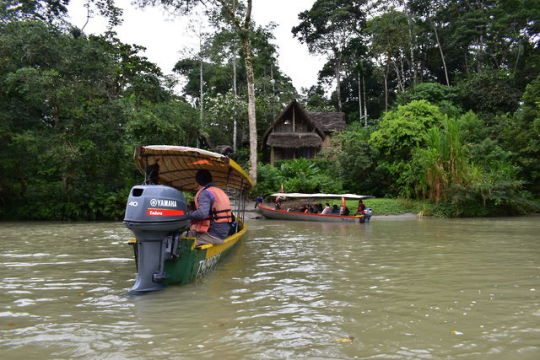





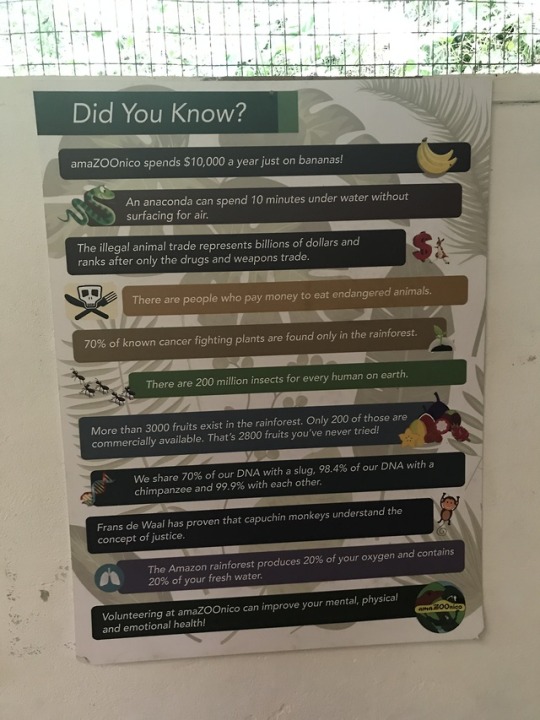

June 29th 2018
First full day in the Jungle, and we have many activities planned. Our breakfast was eggs, pineapple, watermelon, plantains, yoghurt and granola, and coffee. Last night I slept on the queen bed, but I had to get up and pee about 7 times because the sound of the Napo River was messing with me. I’m still sick today, my lymph nodes have been super swollen for like over two weeks now, but onward we go. I whipped out my blue-green poncho, and everyone got rain boots for the boat ride. I sat next to Ginger, my boat buddy, and we drove through the Napo River for over an hour to get to the Amazoonica animal rescue center.
Amazoonico is a wildlife rescue center located in the Ecuadorian Amazon rainforest that rehabilitates, reintroduces, and cares for animals who are victims of illegal trafficking. All of the animals that arrive at the center are brought by the Ministry of the Environment, the result of confiscations from people who have kept them as pets or intended to sell or trade them on the black market. Some animals arrive suffering from multiple physical and behavioral problems which make it impossible for them to live free in the forest. In those cases, they are provided with enclosures similar to their original habitat, where they can live in the most natural conditions possible. In other cases, if the animals arrive in good physical and mental condition and after passing through quarantine, various examinations, and a rehabilitation process, they can be successfully reintroduced back into their natural habitat.
Founded in 1993, Amazoonico is a non-governmental organization created by a Swiss-Quichua couple named Angelika Raimann and Remigio Canelos. Together with Christine von Steiger, they wanted to protect the fauna of the Amazon, creating a center that would receive, treat, rehabilitate, and reintroduce wild animals that had been confiscated from illegal trade. In order to fulfill the plans for reintroduction it was important to create another project that would be exclusively dedicated to protection the rainforest itself, working with the community towards a common goal of sustainable and practical resource use. So came the birth of Selva Viva: a large umbrella project which would come to include 1750 hectares of protected forest, a trilingual school for the neighboring community, and two Eco-lodges which promote ecotourism. The project has been widely embraced by the nearby community and those who visit it daily, and has come to be well-recognized as a sanctuary of care and respect for wildlife. The driving force behind amaZOOnico are the Padrinos, volunteers, and tourists. Each day, they take care of the work with the animals, educational campaigns, and the maintenance of the infrastructure, the collection of funds and the general upkeep of the center.
Our tour guide was from Switzerland and she is working there for two months. She was kind of ditzy, but I think it is because she wasn’t comfortable with her English. On our tour we met toucans first, who while beautiful, are known to be incredibly aggressive and territorial. Their feathers had been plucked for ancient local rituals, and they had been taken to the center to regrow them. However they are now too acclimated to living in a cage around humans, so they must stay in the rescue center for the remainder of their lives. Next was the three and a half meter long Anaconda, who had her sensory organ taken out from her tongue, which helped to determine if her prey was dead or alive. She was found as a tourist attraction, and must stay there forever, with her roommate the Boa Constrictor. The Macaws we saw were very special, but very loud. They are often kept as pets, but given away after two years because their owners did not anticipate how noisy they would be. These birds choose their mates for life, and one wild Macaw chose a mate inside the cage, so every day he comes and perches on the top of the chain links so he can be with his wife.
We moved onto the monkeys, and I especially like Mono Capuchinos. This species uses its tail as a fifth hand, and every time tourists come around, one of the monkeys puts on a show. Hunted for their young, the mothers are usually shot so that the young they carry will fall to the ground and can be captured. Oftentimes Capuchinos arrive at Amazoonica paralyzed from the fall off their mother’s back. Pecaris, or relatives of wild pigs, were grouped together as a pack in this reserve. As a common dish for holidays, Amazoonica tries to release 8-10 a year away from civilization so they won’t be captured and eaten. Other attractions were the Coati, which reminded me of a possum or raccoon, a wild cat similar to Jaguars, and Amazon River Turtles. My absolute favorite were the Spider Monkeys and Chi Chico. Amazoonica’s Spider Monkeys were to be released soon, with a pack that hung around their group cage. The Chi Chico, Ecuador’s smallest monkey, was found in a backpack being smuggled across the border of Peru. His brother died due to parasites, but he now calls the reserve his home.
Of all these animals rescued, 1/3 survive at stay, 1/3 die, and 1/3 survive and our released. To be honest, this was identical to a Zoo for me. I didn’t feel that their project had stayed our course for its goals and mission. Yes they gave the animals similar habitats to that of their natural homes, but to allow tourists to come view them in cages for money, and their ratio of those rehabilitated in the wild, did not convince me that they were truly following the founders’ beliefs.
After our fairly brief visit, we traveled a short distance to eat lunch by the river. We were served this rice conglomeration with chicken, corn, and all sorts of vegetables mixed in. For sides we had tomatoes, lettuce, apples, huge bananas from Colombia, and water. I was pretty much choking on the rice the whole meal and attracting way too much attention. I sounded like a dying squeaker toy with a tomato face to boot. I blame the Ahi sauce and my closed off throat, plus the drizzling rain and cold wind. Lunch was quickly over and we were off to visit the Tiyayaku indigenous community guided by Marco. Our first demonstration was artisanal gold mining. The community is named after the river they mine in, and there are 15 families with approximately 68 people. To mine they arrive along the river at 4 am, carry big pots that weigh around 40 kg. They stay there till 3pm, usually waiting till the water is high and coming from the north, for that is when they find the most gold. It’s important for the Tiyayaku to have strong metal sticks, helping dig up more minerals to bring back to the village. Once they have dug up the ground and moved it into the circular bowl, they partially dip it into the river, moving the bowl in a specific circular motion to keep the gold grain inside. After this practice, they used to put the gold in their mouth to separate it from the iron, but nowadays a magnet is used. Women and men alike carry these heavy pots about 15 meters, either on their shoulder or their back. About 90 pots is one gram of gold, and one gram is 20 to 30 dollars in market.
Walking into the village we saw a diverse array of flora species, such as the well-known paradise flower with over 57 types in Ecuador. The indigenous use this plant for shampoo and sweet water; because of this sweet water, its inside petals are house various insects. A wide variety of this flower contributes to many different species of Hummingbirds.
We were led into a large wood-gated common area, where Rosalina, a grandmother of 35 grandchildren, showed us how they utilized the Yuca. With three different types harvested in the beginning, middle, and end of the year, it is the most important and most nutritious of their harvest. They also make the chichi drink, by fermenting this plant. It is so integral to their culture that spouses are chosen based on how well the woman can make this alcoholic beverage. After we all had a taste of the strange-milky vodka-tasting drink, two volunteers were brought up to make ceramics out of clay. This activity has been lost my many communities, because children simply aren’t interested in learning ancient skills. The making of ceramics was vital to this culture, so they could feed their families from pots and bowls, each with a specific purpose.
Our last activity was shooting darts out of the blow guns to hit a wooden toucan. Tactics like this were used to fight off the conquering Incas from invading the Amazon. At the gift shop I purchased a hand-made bowl designed with butterflies, toucans, and a woman. Then it was back on the boat for a quick ride to our cabins. I felt awful after sitting in the cold and the rain. In my opinion, cultural ecotourism activities like this do more good than harm. It seems to be keeping the culture alive against waves of modernization and outsourced labor. Not only does it provide income for the Tiyayaku, it also forces them to keep practicing ancient traditions to showcase their history and development. In terms of our cabins, I also think it is the most practical and sustainable way to combine humans and the environment. By integrating cabins into the landscape, destroying as little of the rainforest as possible, a deeper appreciation of nature is established, and visitors are encouraged to protect this house of biodiversity.
As soon as we got home I took a shower and napped until dinner. But when I woke up I felt even worse; my eardrum was swollen, itchy, and pounding, my throat hurt, I was hacking up globs of mucus, and my head was killing me. After our dinner of cornita frijo, fish, and fruit, I asked Felipe for an ibuprofen, and went to bed around 8:30pm.
The plan is to go to the doctor in Quito tomorrow, so here’s hoping.
0 notes
Text
Weeks 2 - 3, I’ve already done so much! and I (somewhat) remembered to take photos!!

The second Sunday since my arrival, the first full weekend. In the morning Hans and I went for a run through the lakeside forest, the beauty of the trails makes the running tolerable.

Sunday evening, Hans and I went to an FC Copenhagen game. We played a Danish team from Southern Jutland and won 3-2 if I can remember. I can’t consider myself a sports fan, but I recommend attending one of these games if the opportunity presents itself. Being amongst the crowd of rowdy Copenhageners is a lot of fun. If you really want to get into it, figure out what the cheers are before going… and if you’re feeling confident, maybe book a seat in the rowdy section.

Another view of the stadium, rowdy section pictured to the right. They seem to have a great time swaying, jumping, chanting, shouting, and cheering to the beat of the drummer for the duration of the game.

I spent the beginning of Week 2 working on the two old bikes my family had in the side yard in preparation for biking to my first field study on Wednesday. The black one had a frayed gear cable and the grey one had two broken tires, a broken tire-lock, and a broken front-brake. I replaced the broken grey bike parts with the black bike parts and removed the front brake of the grey bike entirely. I really had no idea what I was doing, what seemed simple at first became a two-day project (a tiny handsaw and a hammer were involved in the operation, I lacked finesse and turned to forcing my will upon the old and rusty bike parts).
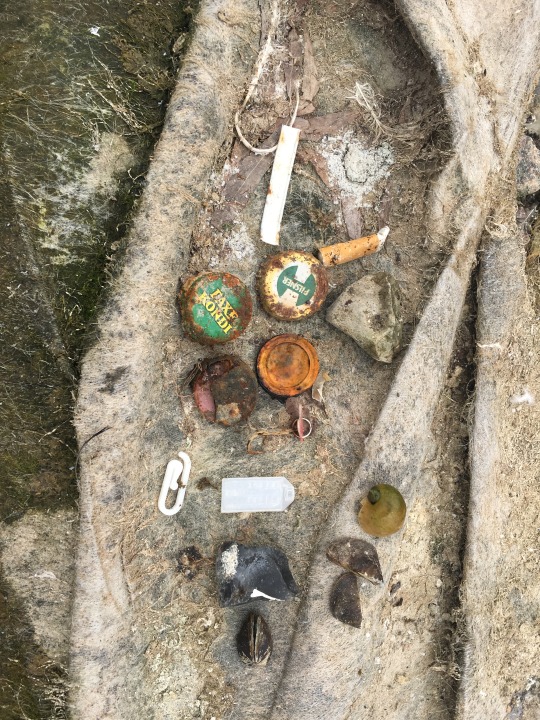
The next three photos are from my first field study with the Urban Ecology course. We traveled to four areas within the city: a shore-side seating area at Sankt Jorgen Sø, Axel Hedes Gade, a small park between some apartments near Axel Hedes Gade, and on a dock in Island Brygge. The field study served as an introduction to the Field Journal assignment we will work on for the entire semester.
Our professor simply asked us to fill the journal with any content relating to our observations of the environments we find ourselves in over our time abroad. Notes, sketches, photos, field samples, anything... we just need to mindfully observe each space. We focus particularly on 3 topics when assessing an environment: (1) Its pros and cons as a habitat for non-human organisms. (2) Pros and cons as a space for human beings. (3) Pros and cons as a space that influences biogeochemical cycles of the city and greater area.
Here is a sample of the garbage scattered around the shore of Sankt Jorgen Sø. I also found broken glass, old clothing, wrappers, bits of plastic, etc. I was also curious about the effect shoreline-type (concrete vs. vegetation) has on the presence of birds.

Axel Hedes Gade, the 2nd area that we met at. Our 3rd area is around the apartment buildings off in the distance. This road runs with many others through this very large field I believe to be part of Amager Vest.

The dock within Islands Brygge we finished our field study at.
Going North (photo taken facing south) up the dock would take you to the Islands Brygge Harbor Baths, one of my favorite spots in the city (Be sure to go during the first 2-3 weeks if you’re here for Winter Semester, its only going to get colder and darker outside! WoOOo!)

I visited the Danish Architecture Museum with my 20th and 21st Century Danish Architecture class. We had an hour to be toured through the current exhibition “Welcome Home,” a historical survey of the Danish home.

I cooked a meal for my host family on the Friday of the 2nd full weekend. I picked up pretty much everything at Torvehallerne, the rest was stuff from home.
Trout stuffed with lemon, red onion, dill, and garlic... basted with a sauce made from butter, dark beer, and leftover stuffing. Artichokes filed with one of the many kinds of cheese I found in the fridge and garlic. I also made some caprese salad.
It was simple and delicious, my host family loved it... there were barely any leftovers between just three of us.

Saturday of full weekend #2. Stopped at the National Museum of Denmark for a few hours. If you really love museums, make this an all-day event... 4 hours only gave me enough time to somewhat thoroughly go through the 1st floor (there are 5 if I can remember).

Lur Horns
Nordic wind instruments. They were used to create an atmospheric background sound for Bronze Age rituals. All of these lurs were found in bogs and are from 1200 - 700 B.C.
This might be what they sound like.

Tirsted (10th century AD)
The plate beside the stone lays out an attempt to translate the inscriptions.
“Asråd and Hildvig raised this stone in memory of Frede, their kinsman. And he was then (the terror of men) and he died in Svitjod (Sweden) and was (the foremost of Frigge’s host); and then: all Vikings.”
Doesn’t make much sense, but this room was one of my favorite in the entire museum. About a dozen of these stones are laid out in the room. I read that when these were first erected they were fully painted in bright color. I find the way the words are etched and stained to be fascinating.

The woman of Himlingøje
From the 1st half of the 3rd century AD. 40-50-year-old woman. Within the woman’s mouth is a piece of gold, called a Charon’s coin. The piece was meant to pay for passage to the realm of the dead. Jewels, beads, bangles, rings, a comb, earthenware vessels, a bronze pail, a dish, ladle and sieve, glass cups, and a silver coin were laid among her. (Information from plaque)
This room and a number of others were filled with remains and the variety of items that were placed beside them at the grave.
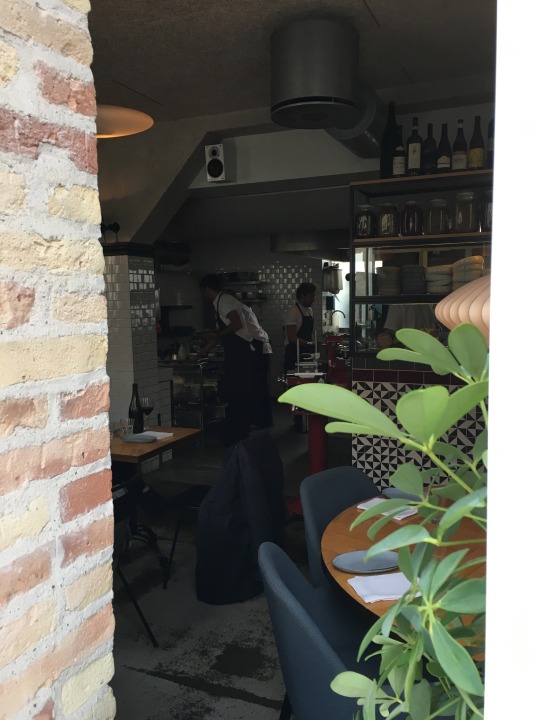
After the museum visit, I had dinner at BÆST, a restaurant that's whipping out freshly fired pizza, fresh veggies, and carefully crafted charcuterie and cheeses. A majority of the ingredients they use come from the eastern Farm of Ideas, a farm founded by Christian F. Puglisi, the lead of BÆST and others like Ralæ, Manfreds, Mirabelle... etc.

Swiss chard, Russian kale, grilled fennel, dried olives, and really really good ricotta. Some GOOD sourdough bread.

Margherita. Tomato sauce, mozzarella, basil. (This was good, but I’d get something with their charcuterie on it if I go another time.)

The view of Peblinge Sø from the bridge of Nørrebrogade. On a weekend night, get together some friends, grab something to go from the great variety of food stops nearby and head on over to the many spots that border these lakes.
I took a stop here after my dinner at BÆST, on my way back to Nørreport Station.

On my Sunday morning run, I found an apple orchard near my house. Off in the distance is a bunch of beehive boxes, some of which contain colonies.

Aarstiderne Farm Harvest Market. A nice festival with food stands to showcase their fresh produce; tours of the farm; local artisans crafting things like chocolate, sea-buckthorn jam, charcuterie, clothing, coffee, etc; a produce market; and general good vibes. Its a bit quite a ways north but was really awesome, I recommend checking in this event and ones like it during your time here.

A stand near one of the produce fields. Showcasing some of the freshly picked produce.

A view of the crowd amongst flowers and produce. This photo and the one below show two different farm areas, both containing pretty much the same vegetation. In this photo they are planting everything together. In the other, they are planting uniformly in rows... perhaps they are testing to see the two different methods effect on how well the plants do.


Ørstedparken a nice park near Torvehallerne. We went here for an Urban Ecology session, continuing our exploration of urban environments as a habitat, a human space, and an influencer of urban biogeochemical cycling.
This is one of many parks that were originally a part of the old defense fortification ring decommissioned in the 1870s. A section of the mote has become the lake and bastions have become small hills within the landscape.

The second field study, this time with my 20th and 21st Century Danish Architecture Course. This is Grundtvigs Kirke, dedicated to N.F.S. Grundtvig, built from 1927 to 1940. The architect is Peder Vilhelm Jensen-Klint... His son and his grandson were involved in the work as well. The church is a centerpiece of a village of similarly styled residential buildings and small storefronts. The style is a mix of Expressionist and Gothic architecture.
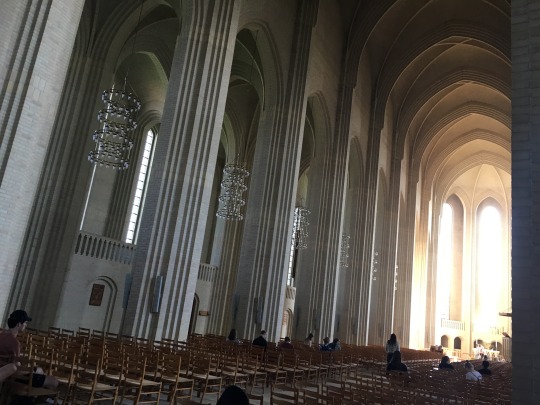
The glowing interior of Grundtvig's Kirke.

Bagsværd Kirke. Architect: Jørn Utzon (you know him, Sydney Opera House). We were to compare and contrast this church with Grundtvigs despite their great contextual and stylistic differences.
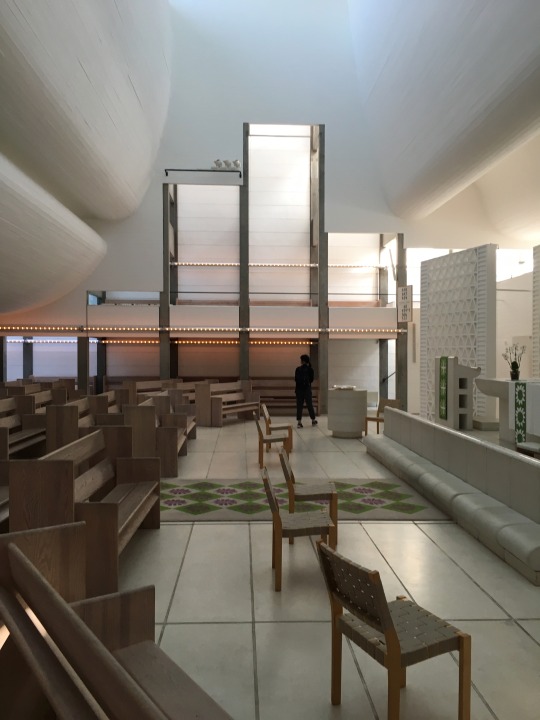
The greatest part of the interior is the vaulting, a sprawling wall of concrete curved into a smooth wave of linen-like white that softly carries light downwards into the room.

The natural lighting works really well with materials and colors. There is a cool, cloud-like softness to the otherwise clean-cut and industrial structure.

Last Saturday night, I decided to try my hand at making pasta from scratch. It was fairly easy, just 400 grams of wheat flour, 4 eggs, salt, and olive oil for the dough. I let it sit, rolled it out, and then cut it into strips. The small meatballs, or pallotine, are just beef, salt, pepper, olive oil. This was my inspiration, I am far from it.

Everything coming together. Pasta’s cooking in salted water, the red sauce has been cooking for around 3 hours, and the meatballs are frying in olive oil.

It’s not beautiful, but it was quite delicious. I’ll be ready for next time!

Prolog Coffee Bar over in Kødbyens District, the best coffee I have had in Copenhagen so far. 2-3 workers serving up stupid good coffee in the small alley-like interior amongst a number of other really cool food stops. I HIGHLY recommend coming here to get a cup and check out the other spots nearby.

This is it. A cortado.
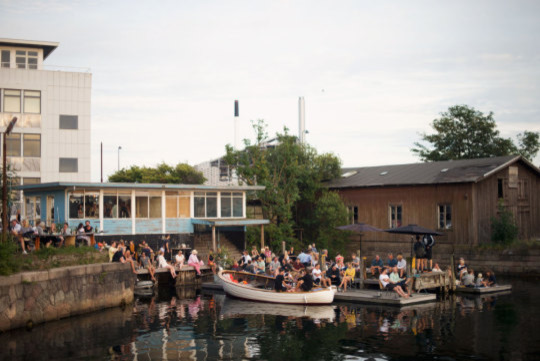
I did not get my own photo of this place, La Banchina, my current favorite spot in Copenhagen. The place serves up a variety of natural wine, beer, baked goods, snacks, and really good, creative meals out of this unusually wonderful place (the kitchen is in a mini greenhouse building). Take a dip into the harbor water, jump into their sauna (50 Kroner), and make some friends. I hope to find myself here many more times, even as the days become dark and damp. (This place is in its full glory during the summertime).
The surrounding area of Refshalevej is worth checking out on its own, I’ll be back to revisit the place in a post sometime later on.

Everyone gathered around for some Snobrød, a Danish tradition of baking bread on a stick. This was available to everyone that stopped by, you just had to find your own stick... this beats roasting marshmallows.
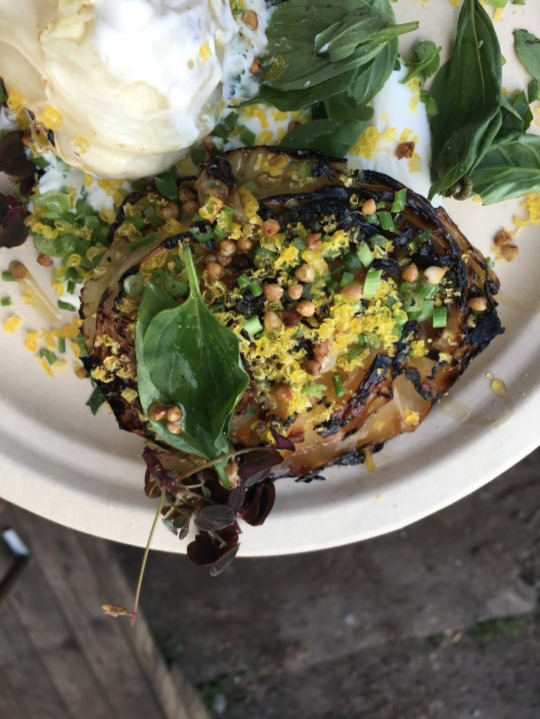
Cabbage, roasted buckwheat, cured egg, fresh creme, chives, and a couple other things. I started eating it before I remembered that I should take a photo of it.
There is never a set menu, they decide what to serve based on what's available and what's on their mind.

Sunset on Vejilesø near my train stop at Holte.
I’ll be posting about Core Course week next!
0 notes
Text
Welcome the Chinese New Year at Lung Hin
I ended 2016 with an outstanding 8-course lauriat at Lung Hin in Marco Polo Ortigas Manila featuring the signature dishes of new Chinese Executive Chef Raymond Leung. It is probably only fitting that I also start 2017 the same way, this time with an auspicious Chinese New Year Set Menu to commemorate the upcoming Lunar New Year.
Lung Hin is offering its 2017 Chinese New Year Menu from January 27 to 29, 2017 for those who want to celebrate this special occasion in style. Many Filipino-Chinese families consider this as their second Christmas season and usually get together with relatives and friends over a bountiful lunch or dinner. With my extended KTG bloggers family, I had a preview of what diners can expect at Marco Polo Ortigas Manila which continues to be one of my favorite dining spots in the city. I even got to do the traditional “Prosperity Toss” for the first time, which signifies an abundance of wealth and long life. Let’s hope that what they say is true.
Lung Hin is located on the 44th floor of the country’s first “Sky Hotel”. With towering views over the busy Ortigas business district, Marco Polo Ortigas Manila’s highly-acclaimed Cantonese restaurant is a luxurious venue to host business meetings and family gatherings.
Proudly displayed in the center of the restaurant is the hotel’s Signature Earl Grape Iced Tea, an award-winning beverage that can be found in all Marco Polo properties worldwide (Read about it here). On January 27, there will also be a New Year’s Eve celebration at the Grand Ballroom on the 7th Floor with live entertainment, calligraphy making, plus selling and display of Feng Shui cures and enhancers for guests to enjoy. Experience a taste of the authentic Yin and Yang set menus with family and friends as you welcome a new year full of blessings.
We were hosted by Ms. Judith Los Baños, Marketing Communications Director at Marco Polo Ortigas Manila, inside one of their private VIP dining rooms. This is the best place to have your family celebrations so it is best to book and reserve your tables as early as possible.
The special 9-course Chinese New Year Menu A started with the Prosperity Toss with Salmon Fish or “Yu Sheng”. This is a traditional Teochew-style raw fish salad that usually consists of raw fish mixed with shredded vegetables and a variety of sauces and condiments including oil, vinegar and sugar. In Chinese history, fishermen along the coast of Guangzhou traditionally celebrated Renri, the seventh day of the Chinese New Year, by feasting on their catches.
The Prosperity Toss is actually an “interactive” course because all the diners are encouraged to participate by tossing all of the items high up into the air. Yu Sheng implies “abundance of wealth and long life” and the tossing action signifies tossing up good fortune, which is why it is popular with businessmen and Chinese in general during the New Year.
The result is somewhat messy but that is all part of the ritual. They say the higher the toss, the bigger the wealth, so we all don’t mind the mess. It’s now time to eat the Yu Sheng salad which is actually quite good. The fresh salmon slices are similar to sashimi but with a sweet and sour vinegar dressing.
Next, we had the Braised Pork Tongue with Dried Oyster and Black Moss. The broth has that Chinese herbal taste and this is a warm and hearty soup appetizer to get our tummies ready for the next courses.
The Braised Crab Meat with Dried Scallop and Asparagus is a light and refreshing set filled with fresh seafood and vegetables. Chef Raymond Leung likes to keep his dishes simple and healthy so expect to find a lot of natural flavors at Lung Hin.
Our fourth course was the Stir-Fried Prawn with Asparagus and Red Wine Pear. This generous serving has huge pieces of juicy prawns that are definitely more than a mouthful.
One of the main courses is the Lung Hin Braised Sea Cucumber Casserole and Assorted Seafood in Hot Pot. This big pot is loaded with seafood such as prawns, fish fillet, and squid with tofu slices, garlic, mushrooms and sea cucumber all inside a heaping broth. It’s quite flavorful and this is probably my favorite dish of the afternoon.
This next one is a heavyweight. The Braised Pork Knuckle with Black Moss and Vegetables is a whole pork knuckle swimming in a savory brown sauce. The tender pork slices off so easily is a good combination to have with the fresh vegetables.
To round off the special Chinese New Year Menu, the Fried Rice with Taro and Chinese Sausage is served towards the end of the set. I still don’t quite understand why the rice is served near the end of the courses during Chinese lauriats, but this one goes really well with the braised pork knuckle and the casserole. Just put them on top of your rice bowl for a very filling and flavorful meal.
Desserts are also served which includes the Sweetened Cashew Nut with Sesame Dumpling and the Pan-Fried Coconut and Brown Sugar Sticky Rice Cake Combination. Both should provide a sweet and tasty ending to the special Chinese New Year Set Menu. From January 10-31, Lung Hin is also offering symbolic glutinous rice cakes presented in round cakes with yam and and brown sugar flavours for P988 or the special Koi-shaped coconut flavor for P1,080. You can also indulge in a delectable Golden Pineapple Pastry that comes in a box of 8 for only P888, freshly made by Lung Hin’s Hong Kong chefs. This is available from January 10 to 31.
If you are planning to spend the Lunar New Year celebrations with the family, hurry and book your tables now at Lung Hin in Marco Polo Ortigas Manila, where luck and good fortune surely awaits.
Lung Hin
44/F Marco Polo Ortigas, Meralco Avenue & Sapphire St., Ortigas Center, Pasig City
720-7777 loc 6621
www.marcopolohotels.com
www.facebook.com/MarcoPoloOrtigasManila
Related links:
A Crystalline Christmas at Marco Polo Ortigas
Weekend Fiesta at Marco Polo Ortigas Manila’s Cucina
Celebrate All Things Swiss at Marco Polo Ortigas Manila
Wine Tasting at Marco Polo VU’s Sky Lounge
Connect Lounge Launches a New Kind of Afternoon Tea
Cantonese Fusion from Lung Hin’s New Executive Chef Raymond Leung
#MarcoPolo#MarcoPoloOrtigas#MPMLungHin#LungHin#Cantonese#ChineseNewYear#LunarNewYear#NewYear#Lauriat
0 notes